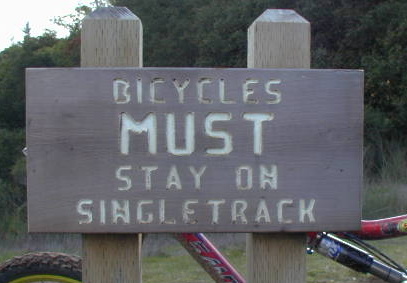
I spent yesterday exploring Marin trails with a couple of locals. The Marin that gets depicted on the maps and in the guide books is a mere appetizer to the feast of Marin mountain biking that actually exists.
The “public” mountain-biking Marin naturally shunts riders onto the well-trammeled routes, mostly on Mount Tamalpais, in the Headlands and in China Camp State Park in San Rafael. That’s all well and good. With Marin continuing to draw tourist and enthusiast riders from all over the world under the banner, “The Birthplace of Mountain Biking,” managers want to provide handy reference points in the form of easily accessible trails and fire roads.
There’s no shortage of mapped and signed routes in Marin for the casual visitor. For the locals, though, there’s a cornucopia of riding that doesn’t make the Tourist Bureau radar. One of the great things about cycling culture is its instant bond effect. Having been fortunate enough to run into a NorCal rider while camping in Oregon, I soon found myself with an invitation to ride the “other Marin.”
We met in Fairfax and took Tamarancho — the Boy Scout camp with signs stipulating “Bicycles must stay on singletrack!” — up to the Pine Mountain loop (of Thanksgiving day “Turkey Ride” fame), circled around the backside (“Furnace”) and then dropped down to the highway for a road burn back to town. In between we explored some routes that, despite having lived in the Bay Area for 3 years and having “done” Marin County mountain biking during visits for nearly 20, I had never seen or even known about.
These were not your typical urban connectors. These trails went on for miles down rocky embankments, across golden fields, through low-lying chaparral and along epic ridges. They transported us into a world apart, quiet and restful and contemplative, far from the madding congestion and din of freeways and shopping malls that California is better known for. These trails, in short, were what what mountain biking is all about. Repack may be the birthplace of mountain biking. These trails are mountain biking’s holy grail.
The hope is that some day such “gray trails” will be made official. Local biking organizations, in tandem with the dedicated efforts of IMBA, are doing yeoman trail maintenance and community outreach toward that goal. My sense as a scarred and somewhat cynical observer is that an Obama Effect is transforming the outdoor recreation arena, where trails are seen not as single-purpose niche “facilities” but multi-use venues open to all, and where “bipartisanship” wins over selfish interests.
Listening to my fellow riders talk about people, associations and park rangers on a first-name basis as “the opposition,” I couldn’t help but think of mountain biking in British Columbia, where I’ve also ridden for nearly two decades. Up there, trail wars are so foreign a concept as to be laughable. Trails pop up overnight and automatically enter the local lexicon. Some get signed, some not. All remain open to everyone.
Not only that, but mountain biking is celebrated in B.C. as a tourist attraction, revenue generator and source of regional pride. Canada issues fat, glossy brochures detailing biking routes everywhere from Vancouver and Whistler to interior backwaters like Revelstoke, Rossland and Golden. To bog down the populace with petty fractious rivalries would not only counter Canadians’ easy-going and friendly natures but would rob municipalities of valuable income.
One can only pray that similar enlightenment is on its way to America, and that a new era of trail accessibility awaits Marin biking denizens. The “other Marin” is just too magnificent and awe-inspiring a place to deprive future generations of its enjoyment.

Thank you! Your grasp of the plethora of riches awaiting even a knowledgable rider of Marin like yourself and the political situation were spot on and most welcome.